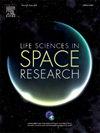Selection and characterization of bacterial consortia for the degradation of space organic waste
IF 2.8
3区 生物学
Q2 ASTRONOMY & ASTROPHYSICS
引用次数: 0
Abstract
Planned human exploration beyond low Earth orbit involves establishing long-term Moon and Mars settlements. Due to the impracticality of continuous resupply from Earth for such missions, it is crucial to develop systems that allow partial or complete in situ recycling of resources necessary for human survival, such as Bioregenerative Life Support Systems (BLSSs), closed artificial ecosystems providing oxygen, food, and water. Microorganisms can play an important role in BLSSs for space missions by producing oxygen, removing carbon dioxide, and degrading organic waste such as food scraps, inedible plant portions, and human faeces. This study aimed to select and identify bacterial communities capable of efficiently degrading organic waste generated during space missions. Bacterial degraders were enriched through sequential batch cultivation in a simulated organic waste mixture like that generated on the International Space Station. Two promising bacterial consortia with high Enterococcus and Clostridia genera abundance, commonly involved in organic waste degradation, were selected. During fermentation, a significant reduction (p < 0.05) in the mass of organic waste, cellulose, and starch content was observed after inoculating the organic waste mixture with the two selected consortia.
降解太空有机废物细菌群落的选择与特性研究
计划中的人类超越低地球轨道的探索包括建立长期的月球和火星定居点。由于在这样的任务中从地球持续补给是不现实的,因此开发能够部分或完全就地回收人类生存所需资源的系统至关重要,例如生物再生生命支持系统(BLSSs),提供氧气、食物和水的封闭人工生态系统。微生物可以通过产生氧气、去除二氧化碳和降解食物残渣、不可食用的植物部分和人类粪便等有机废物,在用于太空任务的生物降解系统中发挥重要作用。这项研究旨在选择和识别能够有效降解太空任务中产生的有机废物的细菌群落。通过在模拟国际空间站产生的有机废物混合物中进行顺序分批培养,细菌降解剂得到了富集。选择了两个具有高丰度的肠球菌和梭状芽孢杆菌属的有前途的细菌联合体,它们通常参与有机废物的降解。在发酵过程中,显著降低(p <;两种菌群接种有机废物混合物后,观察其有机废物质量、纤维素和淀粉含量的差异(0.05)。
本文章由计算机程序翻译,如有差异,请以英文原文为准。
求助全文
约1分钟内获得全文
求助全文
来源期刊

Life Sciences in Space Research
Agricultural and Biological Sciences-Agricultural and Biological Sciences (miscellaneous)
CiteScore
5.30
自引率
8.00%
发文量
69
期刊介绍:
Life Sciences in Space Research publishes high quality original research and review articles in areas previously covered by the Life Sciences section of COSPAR''s other society journal Advances in Space Research.
Life Sciences in Space Research features an editorial team of top scientists in the space radiation field and guarantees a fast turnaround time from submission to editorial decision.
 求助内容:
求助内容: 应助结果提醒方式:
应助结果提醒方式:


